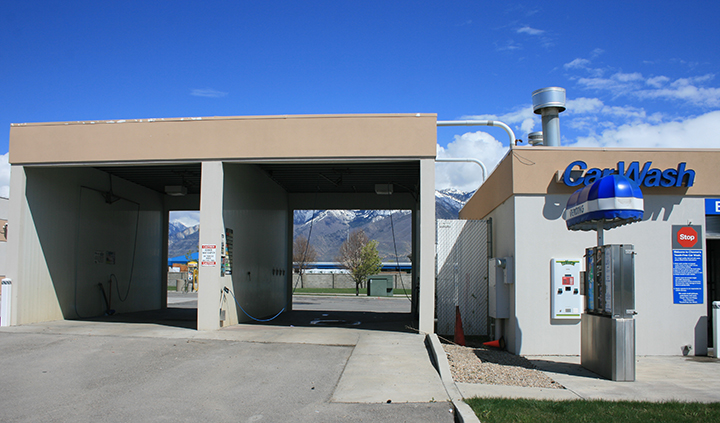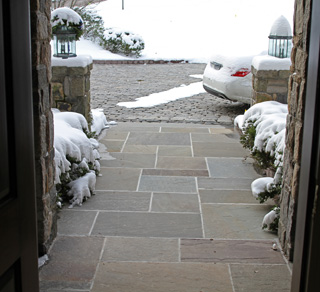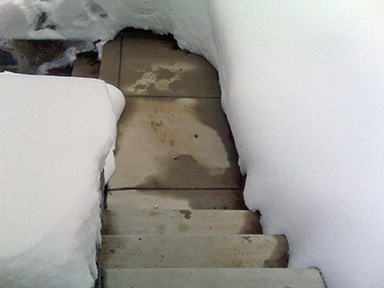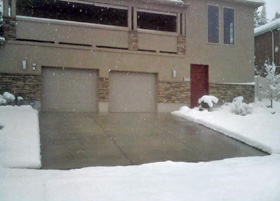Ramping up for Winter: Prepare for the White Stuff with a Radiant Snow Melting System
If the recent heat wave is any indication of what winter will be like, an electric radiant heated driveway installation now is great preparation for big snow in the future. These systems are designed to sense temperature, humidity and other changes that indicate impending white stuff. They’re also fully automated, so your driveway is clear and dry before you leave the house.
Electric snow melting systems are comprised of three main items: the heating element, the controller, and the snow sensor or activation device. They rely on a pavement- or aerial-mounted automated sensor to activate the system when precipitation is detected and temperatures dip below the set point. (The system’s adjustable set point is typically set at 39°F.) The sensor sends a signal to the controller, which in turn sends power through the durable, highly efficient heat cable. When distributed evenly across the surface of a driveway or sidewalk, radiant heat cable can deliver heat quickly and efficiently before the snow has a chance to stick.
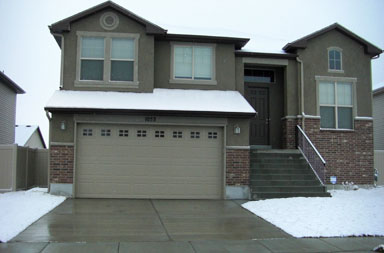
Reasons for investing in an electric radiant heat snow melting system:
Affordability – Warmzone electric radiant heat systems are easily installed in a fraction of the time and cost of more elaborate systems, and still outperform the competition.
Safety – Sometimes icy conditions aren’t obvious until you slip and fall. These problems can be prevented with pavement that’s dry and clear, free of ice or snow during the winter months.
Maintenance Free – Unlike many systems on the market, Warmzone snow melting systems have no moving parts, making them extremely reliable and virtually maintenance-free.
Self-contained – Warmzone electric snow melting systems are fully automated and monitored and controlled by an advanced, UL listed master control unit mounted on a garage wall without sacrificing space.
Efficient –Warmzone snow melting systems are extremely efficient, with 99% of all energy used going directly to snow melting.
Low Operation Costs and Minimal Operation Time –Melt snow on a 300-square-foot area for under $0.50 per continuous hour of operation. Operating time of Warmzone’s automated systems typically run about 30% less than other radiant snow melting systems.
Professional Design and Engineering – In addition to Warmzone’s wide selection of proven radiant snow melting systems and products, Warmzone provides unparalleled system design services and installation support. When it comes to the complete radiant heating solution package, no one can match Warmzone.
Added value and protection –A simple radiant heat installation could save your driveway (and surrounding landscape) from the harmful effects of snow removal equipment and harsh snow melting chemicals.
Ok, so you’re probably wondering how much an automated snowmelt system will cost you. (Get a free quote!) You may be pleasantly surprised with the options available. Regardless of your requirements or budget, Warmzone has the expertise necessary to design and install the perfect snow melting solution for you. Snow melting systems are easily customized to meet your needs – and your budget. You can install radiant heating cable under an entire paved driveway, an 8-10 foot wide strip, or two 24-inch wide tracks. (View some radiant snow melting system options.)
Because Warmzone is not limited to offering just one brand of products, the experts there can recommend – without bias – the system that will best meet your needs. By choosing from Warmzone’s wide selection of proven products, you can be assured that you will be receiving the best service, price and solution available.
For more information about automated snow melting systems, heated floors, or roof deicing systems, contact Warmzone at 888.488.9276.
Radiant Roof Deicing Systems
Invest in Your Home with Roof Heating and Gutter Trace Systems
Right now you probably have a good idea of the condition of your home, from top to bottom. If you’re coming up short above the roofline, the fix could be as simple as a Warmzone electric radiant heated roof or gutter trace system. During the winter months, ice and snow build up can have a devastating effect on your roof, causing gutters to sag and shingles to break free. The good news—an electric radiant snow melting system can eliminate this damage without emptying your wallet.
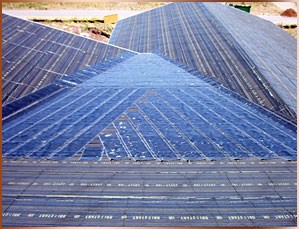
Just what can a good roof deicing system do for you? A well-fitted, properly installed radiant heat snow melting system along your roof line will eliminate prolonged ice-damming during the winter months. Eliminating ice damming, in turn, can prevent unwanted seepage through roofing materials into roof decking. This can cause some serious damage to the roof before finding its way inside to damage ceilings, walls and floors, resulting in mold growth. A Warmzone roof deicing system is the optimal solution for melting snow and ice from roof eaves, valleys, even entire roofs.
What’s in an electric radiant roof deicing system? These radiant heat systems feature three main components:
- Heating Element – The low-voltage roof heating systems feature a polymer heating element, which is polypropylene fused during fabrication for water proofing and to provide protection from alkaline or salt damage. The thin, flexible heating element is installed discreetly underneath the shingles. The roof gutter trace systems feature self-regulating heat cable that is placed in the gutters and downspouts to keep gutters free of snow and ice.
- Power/Control Unit – The controller monitors power and output to ensure safe, accurate, optimal system performance. The power unit monitors the heating element under the roof to melt snow and ice, protecting your roof from ice damage.
- An activation device (snow sensor) – Warmzone offers different types of sensors. The aerial sensor (which is typically used for roof heating systems) is a gutter-mounted snow switch. Like the aerial sensor, the pavement mounted sensor also detects precipitation and temperatures to signal the controller when conditions warrant. However, this sensor is installed in the pavement (and is used more for heated driveways and snow melting systems than roof deicing. Both sensors provide fully automated snow melting for your roof deicing system.
Warmzone roof heating solutions are customizable for just about any roof type and configuration. And Warmzone is the recognized industry leader for providing one of the largest selections of state-of-the-art radiant snow melting systems, including electric and hydronic options. Unlike other “one-solution-fits-all” providers, Warmzone bases a solution on your budget and specific needs to deliver the best performing roof deicing, driveway heating, or floor heating system possible.
Determining the ideal heat cable, thermostat and sensor for your roof heating job depends in part on the size, type and construction of the roof, and also on the overall requirements of a particular installation. Warmzone is always available, with the experts and expertise necessary to assess your system and determine what you’ll need to optimize overall performance for your home. So, if you’re ready to pull the trigger on a roof deicing system, give Warmzone a call at 888-488-9276 to discuss your options.

